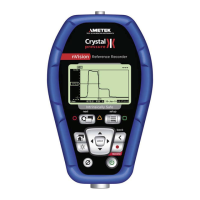Page 26 • Crystal Engineering Corporation
Differential.Mode.(Pressure.and.Temperature)
Upper,.Lower,.Tare.and.Differential.Reading
The Dierential Mode screen has several key features that will help you take quality pressure
and temperature measurements. ∆P can be measured if your nVision is populated with two PM
modules. Conversely, ∆T can be measured if your nVision is populated with two RTD100 modules.
.X
Upper.and.Lower.Readings
Both the Upper and Lower sensor readings are ltered and oers a dampened view of your data.
.X
Tare
Using the Tare function will improve your measurement uncertainty signicantly if used properly.
The Tare function allows you to equalize (normalize) the nVision measurements of the two modules
at a non-ambient datum. The Tare reading will display in the same units as the main ∆P or ∆T reading.
To Tare, simply press the button until the display briey ashes all dashed lines (- - - - -). To
clear the Tare value in the Dierential Mode, hold the button for 3 seconds until the main
display readings change from (- - - - -) to (- - -).
.X
Differential.Readings
Dierential Pressure: The Tare function allows you to equalize (normalize) the dierential
pressure at a high static line pressures to improve your measurement accuracy. Therefore, if you
apply the same static line pressure signal to both sensors simultaneously, you should have a ∆P
reading of zero. Due to the allowable tolerance or error for each module from true applied at
elevated pressures, the ∆P reading may have a value other than zero. The Tare function allows
you to normalize both of these readings so that the ∆P reading is zero. Therefore, you will have a
much more accurate ∆P reading than you normally would have if this process was not completed.
The Tare should be reestablished every time you are at a new static line pressure, including vent
condition. For instance if your ∆P reading has 8 inH20 of Tare at 1500 PSI static, when you return
to vent condition this 8 inH20 of Tare will remain in place on your ∆P reading until cleared with
the button.
Dierential Temperature: The Tare function also allows you to equalize the dierential tem-
perature or resistance measurements to improve your measurement accuracy. Therefore, if you
apply the same temperature or resistance signal to both RTD100 sensor elements simultane-
ously you should have a ∆T reading of zero. Due to the allowable tolerance or error for each
module from true applied at dierent temperatures, the ∆T reading may have a value other than
zero. The Tare function allows you to normalize both of these readings so that the ∆T reading is
zero. Therefore, you will have a much more accurate ∆T reading than you normally would have if
this process was not completed. Note that generally accepted lab practices should be followed
when trying to establish a common temperature measurement on two independent sensors.
The Tare should be reestablished every time you are at a new temperature or resistance. For in-
stance if your ∆T reading has 0.2°C of Tare at 220°C, when you return to ambient conditions this
0.2°C of Tare will remain in place on your ∆T reading until cleared with the button.

